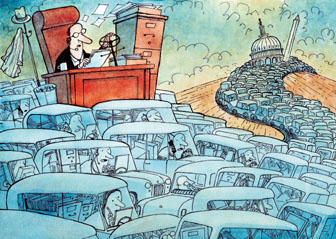Woe is NARPAC
 Drive time, image by David Clark (via The Washington Times).
Drive time, image by David Clark (via The Washington Times).NARPAC is an interesting outfit, a civic think tank of a sort, devoted to improving the District of Columbia. It's leading member(s?) is a suburban-dweller.
Since I too have no compunction making "suggestions" on how other places should do things, I shouldn't be too critical of others doing the same, even if it is from their relatively safe and comfortable suburban abode. (As Graham Allison wrote in the book Essence of Decision, "where you stand depends on where you sit.")
NARPAC produces some great reports. I wish I had the time to write as much, or had the financial support to be able to do so.
On the other hand, there is no question that the organization is car-centric in its outlook* (makes sense, Len Sullivan likely lives in Bethesda), and I wouldn't claim that they accept the point that I make all the time, that DC's competitive advantage comes from its architecture, urban design (which is by and large pedestrian-centric), and history. (I once bristled in a post to themail about NARPAC's comments on the K Street busway project, one of the sections of NARPAC's analysis was labeled "Pedestrians are a hindrance.")
In the current issue of themail, NARPAC calls attention to the suggestions they submitted to the recent DC Appleseed contest, which they put into a separate webpage entitled, "7 Ideas for Solving DC's Problems." One concerned how DC thinks about and plans for transportation. And one of the three subpoints is this:
Second, the car, a success symbol for DC's increasing numbers of adult residents, commuters, and visitors, must be accepted not as a nuisance but as a major source of city revenues and viability: off-street, high-density, variable rate, automated parking facilities can enhance city growth significantly.
I guess NARPAC isn't really a proponent of the planning thrust evidenced in the "latest" thinking in planning including:
-- Death and Life of Great American Cities (45 years old, but still fresh)
-- Cities in Full (a solid, superbly written numbers-based updating of Death and Life)
-- Cities: Back from the Edge (10 years old, a kind of primer based on Death and Life)
-- Geography of Urban Transportation Systems, etc.
Plus, I'm not sure that NARPAC has been paying attention to gas prices and energy prices more generally (i.e., Maryland residents receiving service from BG&E are facing 70% increases in the price of electricity), the growth of subway ridership, and the discussion of the future of oil supplies (peak oil).
Furthermore, there aren't really that many successful traditional center cities in North America, and those that are --DC somewhat, Manhattan, Brooklyn (to some extent), Boston (shrinking still), the center city of Philadelphia, Chicago (many parts), Portland, Seattle, Denver, and Toronto, Montreal, and Vancouver in Canada--or at least the most successful parts of those cities tend to be successful because of wildly successful transit and transit links, not automobile-centricity.
It's nice to know that as a nation we still love the technological fix. Automated parking structures being the latest. (But still not much different in intent than Victor Gruen's plan for Dallas in the late 1950s, with huge parking facilities on the outskirts of downtown. Still very automobile-centric.)
But any such suggestions need to be studied via the lens of what comprises the competitive advantage of the District of Columbia, not the competitive advantage of the Maryland suburbs.
Besides architecture, urban design, and history, DC's other competitive advantage centers upon transit and mobility options other than the automobile.
While NARPAC recognizes this in their third suggestion, "Continue to Expand Metrorail within DC" it doesn't make sense to "balance" mobility between the car and transit. Most planning initiatives are still very much car-centric, and automobiles hog most of the money, service, and attention when it comes to planning for land use and transportation.
There is no balance now. The car is favored. And the automobile lobby, particularly in the guise of the American Automobile Association, wails any time advocates call attention to automobile favoritism and suggest other alternatives.
Automobiles are plenty subsidized already. Yielding valuable land to parking structures should hardly be a priority for the District of Columbia.
-- DC has 36 WMATA stations.
-- Montgomery County has 12 (two are shared with DC -- Takoma and Friendship Heights]
-- Prince George's County has 15 [one is shared with DC -- Capitol Heights]
-- Arlington County has 11 WMATA stations.
-- Alexandria has 3 WMATA stations.
-- Fairfax County has 4 WMATA stations.
Is it a surprise that DC and Arlington have some of the more densely developed areas, given the prevalence of transit, and the most pedestrians, while Fairfax and Montgomery Counties are known for car-dependence (although MontCo does an excellent job supplementing heavy rail with the RideOn bus system)? And the energy and environmental costs of this pattern of development are much reduced compared to car-centric ways.
(Note that rises in electricity and fuel costs impact transit significantly, but less so than for individually-driven automobiles...)
Index Keywords: car-culture; mobility



0 Comments:
Post a Comment
<< Home